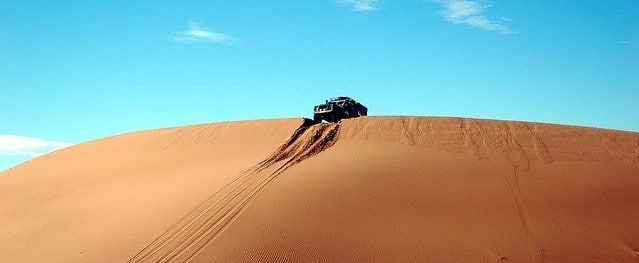I’m Simon, founder of Financial Expert. This beginners guide covers the essential things you need to know when building an investment portfolio.
It’s the most popular guide on Financial Expert.
In this article, I’ll be touching on many of the concepts explored in our free investing courses. It’s time to bring it all together and begin putting that knowledge into practice!
There are two ways to build an investment portfolio from scratch:
THE TWO ROUTES TO PORTFOLIO PERFECTION
Managed Services
Using a wealth management platform
Perfect for beginners
A hands-off investing experience
Tailored to your risk profile
Instant diversification in a few clicks
Management fees of ~ 0.5%
Efficient for smaller portfolios
Self-Managed
Placing trades via a stockbroker
For experienced investors
Perform your own research
Hand-pick funds and shares
Take personal responsibility
Pay fees on every trade
Prohibitively costly for small portfolios
Choosing a managed portfolio service
Until recently, a fully managed portfolio service was only available through a financial adviser at the cost of £500 + per year. For small portfolios (under £250,000) these high minimum fees would have eroded returns. It wasn’t worth it.
However, two UK investment firms have recently taken the industry by storm; Nutmeg and Wealthify.
By focusing on their tech, they can offer a personalised investment approach and low fees for the first time. This group of high tech investment platforms are better known as robo-advisers.
Nutmeg and Wealthify charge a portfolio management fee I happily pay in return for the instant investment of my funds across multiple asset classes.
That’s right, I personally have a Stocks and Shares ISA with both and have loved the experience so far. As a member, I can share a referral link which I’ve added to the table below which will provide a bonus to each of us if you sign-up through that link.
Fully managed service
Stocks & shares ISA
Ethical investing option
Initial fee
Free
Free
Exit fee
Free
Free
Trading fees
Free
Free
Portfolio management fee
0.45% per annum
0.6% per annum
Founded
2011
2014
Minimum investment
£500
£1
Trustpilot® rating
FE rating
FE referral bonus:
0% management fees for 6 months if you join through the referral links in this article.
£25 sign-up bonus if you join through the referral links in this article.
Fee data and Trustpilot ratings taken from providers on 28/06/2020. Providers may change their fees & charges. Some charges vary by account size and investing style. For updates or corrections, please contact me.
Remember, to grab those referral bonuses you’ll need to sign up through the links above. I’ve also published separately a Nutmeg review and Wealthify review for people hungry for more detail.
How to self-build an investment portfolio
1: Choose a stockbroker or investment service
Comparing stockbrokers is tricky but rewarding.
Due to the massive choice of providers and services, you might get slightly lost before finding your perfect match.
In our dedicated guide, I encourage readers to focus on fees and charges. You should be actively reducing your investing costs by seeking out a broker with competitive fees.
We’ve shortlisted the best of the best UK stockbrokers for retail investors below to help your search:
Trade shares with zero commission. Open an account with just $100. High performance and useful friendly trading app. Other fees apply. For more information, visit etoro.com/trading/fees.
Large UK trading platform with a flat account fee and a free trade every month. Cheapest for investors with big pots.
The UK’s no. 1 investment platform for private investors. Boasting over £135bn in assets under administration and over 1.5m active clients. Best for funds.
Youinvest stocks & shares ISA offers lower prices the more you trade! Which? 'Recommended Provider' for last 3 years.
Choose a pre-made portfolio in minutes with Nutmeg. Choose your level of risk and let Nutmeg efficiently handle the rest.
Buy and sell funds at nil cost with Fidelity International, plus simple £10 trading fees for stocks & shares and ETFs.
Capital is at risk
Trade stocks & options on the advanced yet low-cost Freedom24 platform that arms retail investors with the tools to trade like professionals.
Capital is at risk
Please also see our Hargreaves Lansdown review, our AJ Bell review and interactive investor review.
2: Check your time horizon

Review your personal situation and make a decision; just how long can you lock away your money in investments?
2 years? 10 years? 30 years?
Visit my investment time horizon guide to understand whether your time horizon is too short for riskier investments like buying shares or investing in property.
A rule of thumb is to only invest in shares if you are sure you won’t need to access that money for 5 years or longer. For highly speculative investments such as investing in land, your horizon should be even longer term.
3: Understand your risk profile

Take my quick risk questionnaire to discover if you have the risk tolerance that will allow you to enjoy riskier investments.
Successful investing doesn’t require huge levels of risk though. Many investors enjoy a reliable return from conservative bonds and modest stakes in reputable businesses.
You will live with your investment portfolio for many years. It’s crucial that you are honest with yourself and pick investments which are compatible with your mind-set.
4: Choose a high-level asset allocation

An effective portfolio contains a mix of different ‘asset classes’, which are investments with different characteristics. Shares/Equities are one type of asset class, and bonds are another. You’ll need to decide what to invest in at this summary level before thinking about individual trades.
Blending different asset classes together in your portfolio is one of the diversification techniques which can enhance your return whilst reducing your risk.
Many investors opt for the following example asset allocations as a simple starting point. I have grouped these to correspond to the different investor risk profiles from my questionnaire.
Example Asset Allocation: Adventurous Investor
- 80% Equities | 20% Bonds
- 60% Equities | 20% Property | 20% Bonds
- 60% Equities | 15% Property | 15% Bonds | 10% Cash
Example Asset Allocation: Balanced Investor
- 60% Equities | 40% Bonds
- 45% Equities | 10% Property | 40% Bonds
- 45% Equities | 10% Property | 30% Bonds | 10% Cash
Example Asset Allocation: Cautious Investor
- 40% Equities | 60% Bonds
- 27.5% Equities | 7.5% Property | 70% Bonds
- 25% Equities | 5% Property | 50% Bonds | 20% Cash
Example Asset Allocation: Risk Adverse
- 20% Equities | 80% Bonds
- 10% Equities | 10% Property | 50% Bonds | 30% Cash
Asset allocations are like recipes. They are completely flexible and can be tailored to your preferences.
As a beginner, it makes sense to stick to a tried and tested allocation. But as you discover more about investing and gain more experiences, it’s natural to experiment and tweak your holdings.
The logic which drives this step is that higher equity allocations deliver higher returns, but introduce more risk. If the bond & cash allocations are increased, portfolio risk reduces, although so too does the expected return.
Remember that the portfolio is designed to meet your needs, which might not be typical. In my own asset allocation, for example, I give a large weighting to cash. This was in response to attractive government incentives on offer and my desire to buy a house in the short term.
Alternatively, if your were building an investment portfolio for retirement, you might decide to tamp down the allocation to equity to give your balance greater stability.
5: Design a sub-asset class portfolio allocation

The portfolio examples above give only a high-level shape to your investments. It’s how you invest your money within those asset classes which defines its character.
Will you invest in small companies or large ones? Will your portfolio have a worldwide exposure or a national focus?
You answer these questions with your sub-asset allocation.
You will generally want to spread your money widely across different geographies, industries and company size. The more diverse the mix; the more resilient it will be to sudden shocks.
You may begin to appreciate that this step is just as important as step 3 in determining the risk and return of your portfolio.
A 40% allocation to equities could generate more risk than a 60% allocation if the sub-asset classes chosen in the first case were high risk, such as investing in emerging markets.
Therefore, you’ll want to consider your risk profile again when determining how to sub-allocate. I will use the example of equities to show what different sub-asset allocations could look like for different risk profiles:
Example sub-asset allocations for equities

Adventurous Investor
- 30% UK large companies, 20% UK small companies, 30% worldwide, 20% emerging markets
Balanced Investor
- 50% UK large cap, 10% UK small cap, 30% worldwide, 10% emerging markets
Cautious Investor
- 70% UK large cap, 10% UK small cap, 20% worldwide
Risk Adverse
- 70% UK large cap, 30% worldwide
I increase the proportion of UK investments to reduce the risk level of equities. The UK is a relatively stable democracy, which poses no foreign exchange risk to a UK investor. I also reduce exposure to emerging markets and smaller listed companies as these are higher risk equity categories.
For corporate bonds, higher risk portfolios include generous quantities of ‘junk bonds.’ These are bonds with lower credit ratings and therefore higher yields. Cautious portfolios will feature bonds from trustworthy sources such as stable governments and large corporations.

Choosing your sub-asset allocation is the most judgemental phase of building your investment portfolio. Therefore, take your time. Resist the excitable urges to invest before you have sketched out the whole picture.
If you’d like to peek at my own sub-asset allocation – you can! I use peer to peer lending platforms in place of bonds.
To read more about asset allocation, take a look at the best asset allocation books.
6: Choose a portfolio approach – funds v shares

Should you manage a portfolio of 20+ individual company shares, or buy a fund that invests in a basket of companies for you?
Our article How to invest in shares and the stock market lists the pros and cons of each approach.
Choosing a stockbroker before you’ve selected an investing approach is like walking into a restaurant before choosing a cuisine. Investment platforms are generally priced to suit one type of investor or another – so it’s important to know what type of purchases you’ll be making to ensure you’re choosing the right investment partner.
7: Pick funds or shares within each sub-asset class.

On Financial Expert, I enthusiastically recommend taking the fund route over buying individual shares.
Why?
- Lower cost
- Ease & convenience
- Instant diversification
- Access to some investments that would be otherwise very difficult to access as a retail investor.
The industry leader Vanguard offers a range of funds with low management charges of less than 0.3% per year in common sub-asset classes.
Here is a glimpse of their selection of equity funds, which cover several of the sub-classes discussed above. Each fund is diversified across at least 20 individual holdings.

I encourage you to research Vanguard and their funds before you look elsewhere so that you can use their funds as a good benchmark.
Picking specific funds is a huge topic which I can’t hope to cover in this overview article. Please explore our other Foundation and Intermediate topics for further information.
8: Deposit funds and invest!
The final exciting step is to transfer money into your investment platform from your bank account to begin your investing journey.
Read more about building an investment portfolio in our guide to the best portfolio management books, the best wealth management books and the best financial planning books.
Our article ‘How to invest in shares and the stock market‘ takes you step-by-step through the information you will need to execute a share purchase. Buying funds is even more straight forward.
Check out how to spot investment scams to learn about red flags and methods of checking the legitimacy of investments before you spend a penny.
Course Progress
Learning Summary
How to Build an Investment Portfolio (For Beginners)
Understand your time horizon. If you can only lock money away for less than five years, then shares and other long term investments will not be a good fit.
Understand your risk profile. You need to be comfortable with the level of risk and the volatility that your portfolio might experience.
Choose a high-level asset allocation. Higher risk strategies use more equities and property. Lower risk portfolio's include more bonds and cash.
Design your sub-asset allocation. Divide your asset classes further by regions or by industry. This way, you will ensure that each asset class is as broad as possible.
Choose an investing method. Will you create your portfolio using lots of individual shareholdings and bonds, or will you use funds to quickly access instant diversification?
A saver who can invest £250 per month for 30 years, will likely earn £100,000+ more if they invest it in the stock market rather than a savings account. A life-changing amount of money is at stake.
Research individuals funds and shares to build your portfolio. If you are investing directly, you will want to ensure you have more than 20 individual holdings per asset class. If you are researching funds, stick to index-tracking funds with low fees.
Deposit funds and place your first trade!
Quiz
Next Article in Course
Before you move on, please leave a comment below to share your thoughts. What mix of assets do you think will give you the right balance of risk and reward? Have you included any alternative investments in your portfolio?










Comments 5
F*ckin’ awesome issues here. I’m very glad to look your article. Thank you a lot and i am having a look ahead to touch you. Will you please drop me a mail?
I couldn’t refrain from commenting. Exceptionally well written!
After hours online and endless YouTube video’s, this is excellent advice for a beginner. Its really excellent. Thank you.
Fantastic article that simplifies complexity using clear, easy to understand language. A rare art.
I fount the article very encouraging particularly as a “Balanced Investor” it confirms what I am already doing.
My disappointment in my portfolio has been my Corporate bond holding which for the last 5 years has consistently been negative.